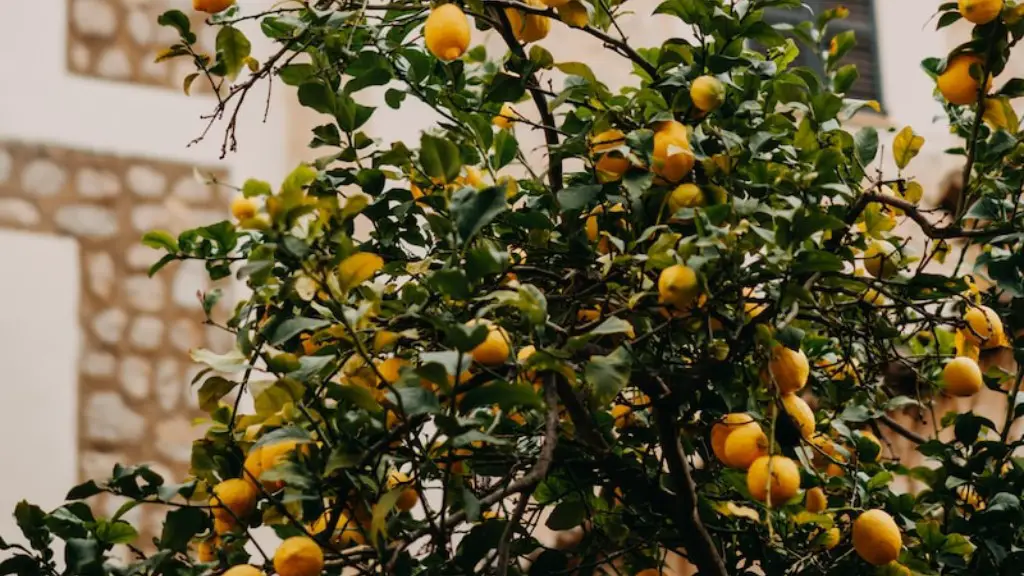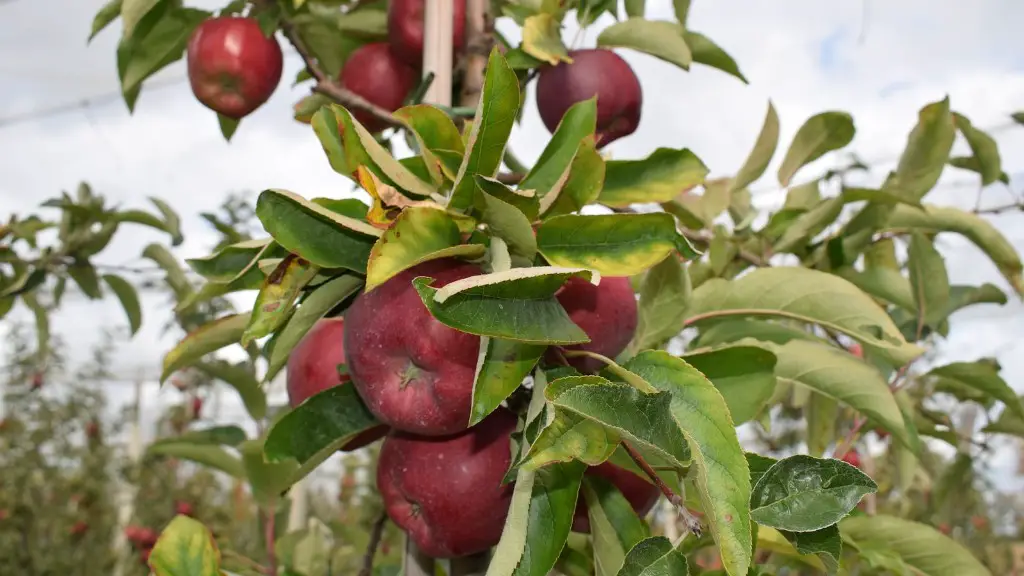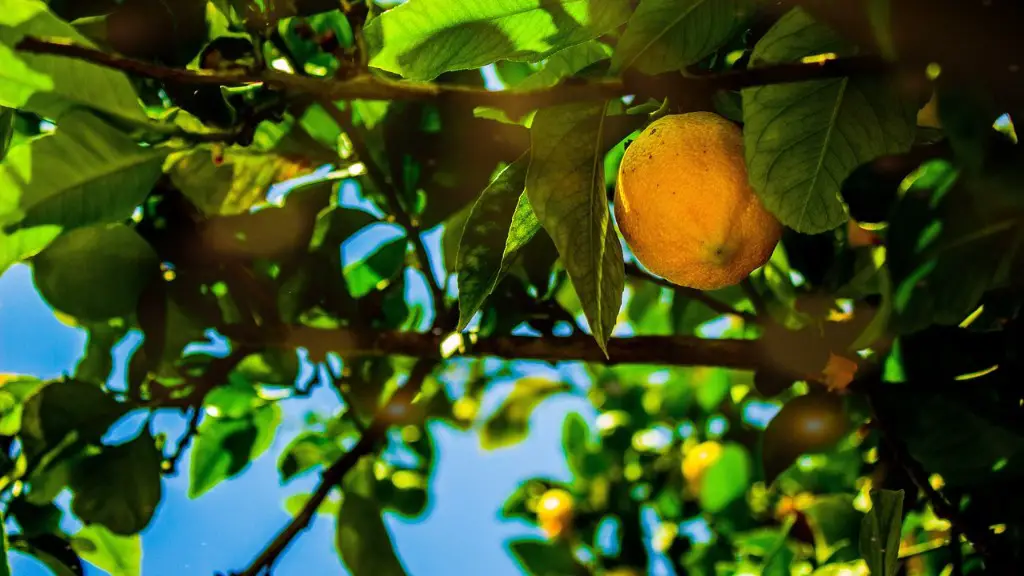Growing your own citrus grove is an exciting way to save money, reduce waste, and enjoy the fruits of your labor. Planting a lemon tree in your yard or in an appropriate pot can provide you with harvests of lemons year round. The following steps will aid you in successfully planting your own lemon tree.
First, choose the variety for your tree. There are a number of different species available, each of which will produce different sized and flavored lemons. Research the different types of lemons and decide which one will work best for your needs.
Next, select a location in your yard to plant your tree. When choosing a spot, consider the amount of light and water the tree will need, accessibility for harvesting, and any potential environmental hazards that could affect the tree. Make sure to keep the lemon tree away from other trees to avoid competition for nutrients.
When planting the tree into the ground, dig a hole twice as wide and deep as the container the tree is in. Remove the tree from the container and place it in the hole, filling any excess space with soil. Once the tree is planted, water it immediately. Keep the soil moist but not swampy. Fertilize the tree twice a year with a citrus fertilizer.
You should also mulch around the base of the tree. This helps conserve moisture, prevents weeds, keeps the soil cool, and enriches the soil with trace nutrients. Mulch in a roughly two-foot-diameter circle around the tree, and make sure to maintain the mulch within that circle.
Finally, prune your lemon tree to promote growth and maintain shape. Keep the center of the tree open and remove any dead wood, water sprouts, or suckers. Pruning during the early spring will also help to maintain the size and shape of the tree.
By carefully following these steps you will be able to successfully grow your very own lemon tree and enjoy harvests of lemons year round.
Common Citrus Varieties
When selecting a variety for your lemon tree, it’s important to consider the climate in which you live. If you live in a warm climate, such as in California or Florida, your choices will be much greater. However, if you live in an area where winters can be harsh, be sure to choose hardy varieties that can withstand the cold.
The most common varieties of citrus trees include the Lisbon, Eureka, and Meyer lemons. Lisbon lemons are a classic grocery store lemon, making them a great all-purpose choice. Eureka lemons are smaller, more acidic lemons, while Meyer lemons are larger, sweeter lemons. Similarly, there are many different types of oranges, such as navels, Valencia, and blood oranges.
When selecting a variety, be sure to consider the size of the tree; some varieties, such as pummelos, will grow much larger than other types. Depending on your space limitations, you may need to choose a dwarf variety such as Meyer Lemon ‘Improved Meyer’ or the Grapefruit ‘Flying Dragon’.
Finally, don’t forget to research the different types of citrus trees and find one that will work best for your needs and climate.
Preparing the Soil for Planting
Preparing the soil before planting is essential to the health of your lemon tree. To prepare, remove any debris or weeds, then lightly water the soil. A soil pH tester can be used to test the soil’s acidity and adjust if necessary. The ideal pH level for citrus trees is 6.0 to 6.5.
Once you have prepared the soil, dig a hole twice as wide and deep as the container the tree is in. Add compost to the hole to enhance the soil structure and help the tree establish faster. Then carefully remove the tree from the container and place it in the hole. Backfill soil around the tree, making sure to pack it firmly. Do not bury the tree deeper than the original pot. Give the tree a thorough watering to help settle the soil and remove any air pockets.
Once you have completed these steps, you are ready to plant your lemon tree.
Caring for Your Lemon Tree
To help your lemon tree grow and thrive, proper care must be taken. When the tree has been planted, it is important to Mulch around the base of the tree to help conserve moisture, prevent weeds, and keep the soil cool. The mulch should be kept within a two-foot-diameter circle around the tree.
Your lemon tree will need to be watered regularly. Water deeply at least twice a week, or more during the summer months. Add mulch to help the soil retain moisture, and make sure you avoid over-watering. Check the soil about 2 inches down, if it is dry then it’s time to water your tree.
Fertilize the tree twice a year with a slow-release citrus fertilizer. This will help provide the tree with the necessary nutrients it needs to grow and produce lemons. Pruning is also important, as it helps shape and encourage the growth of the tree.
Finally, watch for pests such as citrus aphids, mites, and scale. Keep the leaves dry to avoid the development of fungus, and watch for signs of lawn grass competing with the tree for nutrients.
Harvesting Your Lemons
It can take up to three years for a lemon tree to bear fruit, but many will start producing lemons within one or two years. When the lemons are ready, they will appear green and a little soft. As they ripen, they will turn yellow and begin to soften. Carefully pick the lemons off of the tree, making sure to avoid any budding flowers or immature fruits which could potentially affect future harvests.
If you aren’t ready to harvest the fruit right away, it can be set aside in a sheltered area. Lemons will keep in a cool, dry place where they can hang until you are ready to use them. They can also be kept in the refrigerator for up to two weeks.
Enjoy harvesting your lemons and creating recipes with the fruits of your labor!
Tips for Preventing Disease and Pests
One of the most important steps in successfully planting a lemon tree is preventing disease and pests. Properly fertilizing and mulching will help promote healthy plants and protect them from potential pests and diseases.
Regularly check your lemon tree for signs of pests or disease, such as the citrus gall wasp, citrus whitefly, or fungal rust. If any signs are found, take immediate steps to remove the pests and treat any disease. Do not hesitate to contact a qualified arborist if the problem is more severe. Taking preventative steps early is key to avoiding further damage to your tree.
Lemon trees are relatively pest-resistant, and are very adaptable to different climates. Regular maintenance, such as pruning and fertilizing, will help keep your tree healthy, while preventing diseases such as fungal rust. Be sure to harvest all lemons to prevent the spread of disease, and keep the leaves dry to avoid the development of fungus.
Conclusion
Planting a lemon tree is an rewarding endeavor which will provide you with delicious, home-grown lemons. After selecting the right variety for your climate, be sure to prepare the soil and plant the tree correctly. Carefully mulch and fertilize, and keep an eye out for pests and diseases. With proper care, you will be able to enjoy harvests of juicy, freshly picked lemons for years to come.




